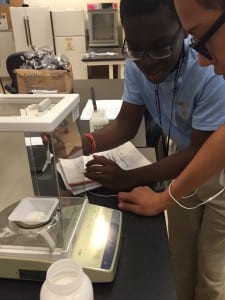African Americans make up 11% of U.S. workforce but only 6% of STEM workers; 83% of SMU STEM students pursue grad school

The U.S. Department of Defense has awarded the STEMPREP Project at Southern Methodist University a $3.78 million grant to support its goal of increasing the number of minorities in STEM fields.
The grant follows a $2.6 million grant in 2014.
According to a report just released from the Executive Office of the President, 21 percent of Hispanic men and 28 percent of black men have a college degree by their late twenties compared to nearly half of white men. The 2013 U.S. Census Bureau reports that African Americans make up 11 percent of the U.S. workforce but only 6 percent of STEM workers. Hispanics make up 15 percent of the U.S. workforce, but just 7 percent of the STEM workforce.
To create more diversity in STEM fields, the STEMPREP Project, based at the Annette Caldwell Simmons School of Education and Human Development at SMU, recruits bright, science-minded middle school students for the first phase of the 10-year program.
One hundred seventh and eighth grade minority students live on the SMU campus through August 1 for six weeks of college-level biology, chemistry, statistics and research writing and presentation classes, laboratory techniques course, and the creation of a final in-depth research presentation on a disease. Each day begins with class at 8:30 a.m and wraps up after study hall at 8:30 p.m.
Eighth-grader Walter Victor Rouse, II wants to be a heart surgeon and professional basketball player to honor his grandfather, Loyola basketball standout Vic Rouse, who died from heart disease before Walter was born. Vic Rouse was an honor student at Loyola University in 1963 when his rebound and basket in overtime clinched the NCAA basketball championship for Loyola. Rouse died in 1999 at age 56.
STEMPREP identifies talent early and nurtures it with practice and coaching
As a STEMPREP student, Walter is part of a program that boasts an impressive success rate – 100 percent of STEMPREP project students who finish the program attend college and 83 percent go on to graduate school to become physicians, pharmacists, dentists, researchers or engineers.
“Being in this program empowers students,” says Charles Knibb, STEMPREP director of academic affairs, an SMU research professor and a former surgeon.
Moses Williams, executive director, founded the program in 1990 when he was director of admissions for Temple University School of Medicine in Philadelphia.
“As a gatekeeper, I realized there were not a lot of minorities being considered,” he says. “I wanted to change that.” He compares the program to training young athletes: Identify talent early and then nurture it through practice and coaching.
Eighth-grader Beatriz Coronado of Marietta, Georgia, says she would be spending the summer taking care of her little brothers if she wasn’t at SMU as part of STEMPREP. Instead she recently completed her favorite lab so far, an enzyme-linked immuno assay simulation that detects and measures antibodies in the blood. She plans to become a family physician.
Dallas eighth-grader Tomisin Ogunfunmi says he didn’t know he could be so independent until he spent six weeks on the SMU campus at STEMPREP last summer. Now he looks forward to next summer when he will work in a Philadelphia university research lab with a scientist as a mentor. He plans to pursue a combination MD/PhD to become a biomedical engineering researcher, possibly at a university.
After participants in the STEMPREP program finish the junior high component, they spend their senior high and college summers working in university, U.S. government and private research laboratories in Philadelphia, Bethesda, Seattle, Toronto and Vancouver.
Taisha Husbands, who graduated from SMU in May with psychology and chemistry degrees, joined the STEMPREP program as an eighth grader.
“I’ve known since I was four that I wanted to be a doctor,” says Husbands, a native of St. Thomas, Virgin Islands. “But I come from a family of teachers and police officers; I thought this program would help me reach my goal.”
Husbands starts medical school in August at the University of Southern California. In the meantime, this summer she is teaching science to current STEMPREP seventh and eighth graders and lives with them in a residence hall on campus. She hasn’t forgotten what it is like to be an eighth grader wrestling with college-level material and created an evening study session for students who wanted extra help.
“When I was in eighth grade, one of the STEMPREP teachers sat down with me at lunch every day to help me with the material,” she says. “Helping these students is one of those pay-it-forward things.”
Follow SMUResearch.com on twitter at @smuresearch.
SMU is a nationally ranked private university in Dallas founded 100 years ago. Today, SMU enrolls nearly 11,000 students who benefit from the academic opportunities and international reach of seven degree-granting schools. For more information see www.smu.edu.
SMU has an uplink facility located on campus for live TV, radio, or online interviews. To speak with an SMU expert or book an SMU guest in the studio, call SMU News & Communications at 214-768-7650.

 Kennewick Man: genome sequence of 8,500-year-old skeleton solves scientific controversy
Kennewick Man: genome sequence of 8,500-year-old skeleton solves scientific controversy Low IQ students learn to read at 1st-grade level after persistent, intensive instruction
Low IQ students learn to read at 1st-grade level after persistent, intensive instruction Richest marine reptile fossil bed along Africa’s South Atlantic coast is dated at 71.5 mya
Richest marine reptile fossil bed along Africa’s South Atlantic coast is dated at 71.5 mya Satellite view of volcanoes finds the link between ground deformation and eruption
Satellite view of volcanoes finds the link between ground deformation and eruption